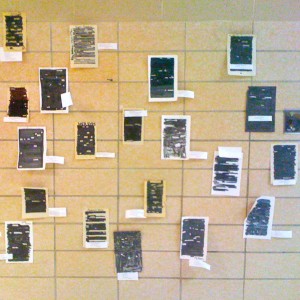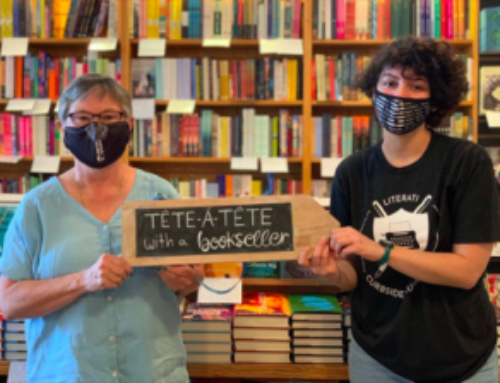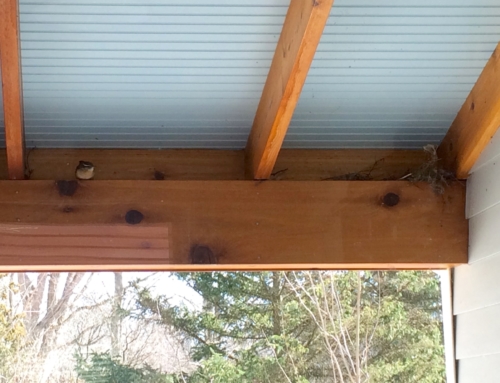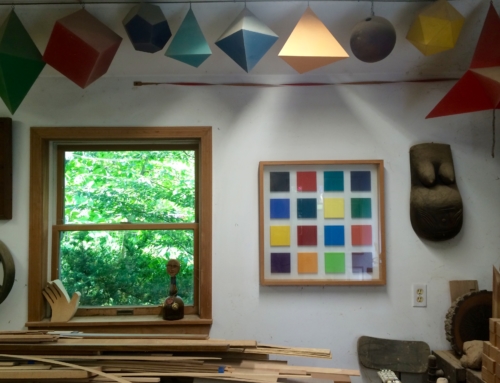The other evening, on my way out of a middle-school basketball game, several towns southeast of home, I was stopped in my tracks by a wall arrayed with taped-up book pages, each one, blacked over, line by line, except for a bright scatter of words, a kind of reverse highlighting. Even from a distance, it looked interesting.
"I wonder if they know about Mary Ruefle!" I exclaimed to my husband and daughter as we walked up to take a closer look. Mary, who's now quite well known for her Erasure Poems, was one of my poetry teachers.
One of the first poems that caught my eye was created by Audrey: "Moonlight / a fierce green giant / a stone creature growing still." Beautiful, I thought, and remembered one of the first books of poems I read cover to cover, Selected Poems of H.D. In a poem called "Heat," which I memorized because I loved its sounds, H.D. (Hilda Doolittle) writes, "fruit cannot fall into heat / that presses up and blunts / the points of pears."
A few wall tiles over, I found Jaylene's wisdom: "High school / what makes you think / everyone knows what / you / have ended up / in / who / cares / most of the kids have problems / too / you’re sixteen / it's not your fault." Right away I was carried back to my own teen years, lying alone in the dark listening to loud music, worrying and wondering what might lie ahead. "You're so long ago and so far away, but my dream lives on forever," sang Todd Rundgren.
Thank you, Audrey and Jaylene, for reminding me of all that.
More than a few students got me to look at familiar words in new ways. I admire the way Sabrina uses "living" (and the way she turned "he" into "her"): "He / r / eyes / stare / back to escape / the / people / Perhaps / the / living / frightened / h / er." And look what happens with a magazine title in Jacob's poem: "Soap / dribbles his / bathroom / in a / National Geographic / minute."
There were dozens more poems—I wish I had room here for all of them—and on the spot I resolved to find the teacher and, if I could, learn more.
To drive into Gobles, Michigan (pop. 829), is to drive into twenty-first-century rural Anywhere, Midwest, a part of the United States that has been particularly hard hit, in every way, at first by a willy-nilly construction craze, and then by a recession. Commercial buildings and parking lots—many newly empty—line the main routes between between small downtowns that largely collapsed in the 1970s.
Encountering any place from a car leaves it silent and surface and uninhabited. I'm glad that I got out of mine, walked back into Gobles Middle School, spent more time with the poems (and their voices), and met the teacher who'd introduced her seventh-grade students to Blackout Poetry, Loriann Harbaugh.
The worn-out books, she told me, were bound for the school's dumpster. "Play, don't read," she'd told her students, and then gently pushed them until they did. Some quiet kids wrote silly poems. Some silly kids wrote silly poems. Some kids with tough lives wrote tough poems. Some made word pictures. Some told stories.
The best sign that something important happened in that play? Quite a few of Loriann's former students (she's done the project for several years) are still making blackout poems, on their own.
Loriann got the idea from author Austin Kleon. The display was a wall of imagination in action. I drove away from Gobles Middle School mulling over a few new ideas and more certain than ever that we should not leapfrog the close at hand in our searches for something interesting—and that public art is a very good idea. I hope you leave this post inspired to stop and look at the next display of creativity that crosses your path–and to take a black marker to whatever newspaper or magazine or worn-out paperback you've got lying around.










For my money, your best post ever, AS.
Thank you, Loriann, Audrey, Jaylene, Sabrina, H. D. and T. Rundgren for the reminder that beauty can be uncovered (or in this case, by covering) in unlikely places, and that good teachers can inspire young writers to discover how extraordinary their voices are.
One of my next workshops, in later April, is entitled 'Found World' and we'll look at Kleon and Ruefle, among others, and we'll do blackouts and erasures, cut ups and more. I'll also share Ann Carson's 'NOX'. I wish you could join us!
Oh Holly. You know I wish I could be there.
Thank you Jules. Coming upon that display was definitely a highlight of my school year. And you know how much I need real-time adventures. I have a feeling some pretty extraordinary voice unveiling happens in your classroom.
Wow — the poems are amazing — thanks for sharing them.